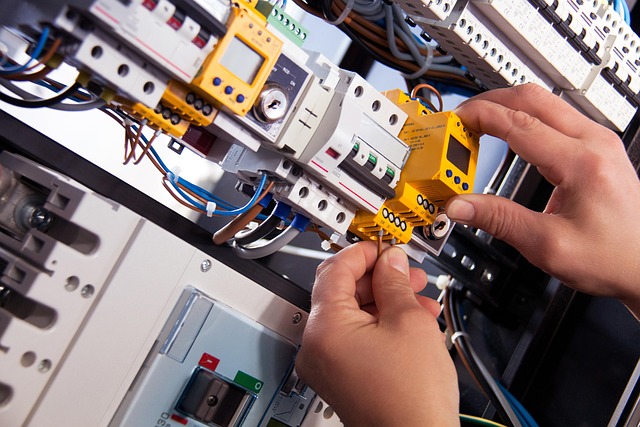
Category: Electrical Inspections and Code Compliance Eugene Oregon
Electrical Inspections and Code Compliance in Eugene, Oregon: A Comprehensive Overview
Introduction
In the heart of Oregon’s vibrant city of Eugene, a critical aspect of urban development and safety lies in the realm of electrical inspections and code compliance. This comprehensive guide aims to delve into the intricacies of this vital process, offering insights for residents, professionals, and policymakers alike. By exploring its definition, global implications, technological innovations, regulatory framework, and real-world applications, we will uncover the multifaceted role it plays in shaping modern cities. Eugene, with its unique blend of historical charm and forward-thinking initiatives, serves as an excellent case study to understand the evolving landscape of electrical safety.
Understanding Electrical Inspections and Code Compliance in Eugene Oregon
Definition:
Electrical inspections and code compliance refer to a systematic process of evaluating and ensuring that electrical systems, installations, and practices within buildings and infrastructure meet established safety standards and regulations. These inspections are designed to identify potential hazards, verify system functionality, and confirm adherence to the National Electrical Code (NEC) and local building codes in Eugene, Oregon.
Core Components:
- Pre-Construction Planning: Before any electrical work begins, thorough planning is essential. This involves obtaining permits, reviewing architectural plans, and ensuring compliance with building and electrical codes.
- Inspections: Qualified electrical inspectors from the City of Eugene conduct on-site inspections at various stages of construction or renovation projects. They verify wiring, grounding, circuit protection, lighting, and other electrical systems’ safety.
- Testing and Certification: Once installations are complete, specialized testing equipment is used to check for proper functionality, voltage levels, and system integrity. Certified electricians ensure all components meet industry standards.
- Maintenance and Retrofitting: Regular maintenance inspections are crucial to identify aging infrastructure issues. Retrofitting ensures older buildings’ electrical systems meet modern safety requirements.
Historical Context:
The concept of electrical code compliance has evolved significantly since the late 19th century when electricity became a common utility. Early codes focused on basic safety measures, but over time, they have become more comprehensive and detailed. The NEC, first published in 1897, has been regularly updated to incorporate new technologies and address emerging hazards. Today, it is one of the most widely adopted building safety codes globally, providing a consistent framework for electrical inspections worldwide.
Significance:
Electrical inspections and code compliance are paramount for several reasons:
- Safety: Preventing electrical fires, shocks, and other hazards by ensuring safe wiring practices, proper grounding, and adequate circuit protection.
- Public Health: Protecting public health by minimizing the risk of disease spread through contaminated electrical systems.
- Property Preservation: Preserving property values by maintaining safe and efficient electrical installations, reducing potential damage from faulty systems.
- Legal Compliance: Ensuring businesses and homeowners adhere to local and national regulations, avoiding fines and legal issues.
Global Impact and Trends
International Influence:
Electrical code compliance is a universal necessity, but its implementation varies across regions due to cultural, economic, and regulatory differences. The global impact of Eugene, Oregon’s approach can be observed through:
- Standardization: The NEC has influenced many international codes, such as the Canadian Electrical Code (CEC) and various European standards, ensuring consistent safety practices worldwide.
- Exchange of Best Practices: Cities like Eugene participate in global forums to share knowledge, fostering innovation and improving code compliance globally.
Regional Trends:
- North America: Stricter building codes and increased emphasis on energy efficiency are driving the adoption of advanced electrical systems and smart grid technologies.
- Europe: Post-Brexit, the EU’s focus on energy independence is leading to widespread modernization of electrical infrastructure and stricter compliance standards.
- Asia Pacific: Rapid urbanization and rising middle-class incomes in countries like China and India are fueling demand for safer and more reliable electrical systems.
Economic Considerations
Market Dynamics:
The electrical inspections and code compliance market is influenced by:
- Construction Industry Growth: Rising commercial and residential construction activities drive the need for regular inspections and upgrades.
- Retrofitting Programs: Older buildings require retrofitting to meet modern safety standards, creating a steady demand for services.
- Technological Advancements: Innovations in testing equipment and digital inspection tools are enhancing efficiency and accuracy.
Investment Patterns:
- Public Sector Spending: Local governments allocate funds for code enforcement, inspections, and education, ensuring compliance with electrical codes.
- Private Sector Investments: Electricians, contractors, and property owners invest in services and technology to meet regulatory requirements and maintain safe systems.
Economic Impact:
- Job Creation: The industry supports a range of jobs from inspectors and electricians to manufacturers and developers, contributing to local economies.
- Energy Efficiency: Compliance with modern codes can lead to more energy-efficient buildings, reducing utility costs for occupants and potential economic savings for developers.
Technological Advancements
Innovation in Electrical Inspections:
- Digital Inspection Tools: Handheld devices and mobile apps enable inspectors to document findings, access code references, and generate reports digitally, enhancing efficiency and data accuracy.
- Smart Testing Equipment: Advanced testers can perform complex calculations, detect faults, and provide real-time feedback, improving inspection speed and reliability.
- Drone Technology: Drones equipped with high-resolution cameras and sensors are being used for overhead inspections of power lines, transmission towers, and hard-to-reach areas, enhancing safety and accessibility.
Emerging Technologies:
- Internet of Things (IoT): IoT devices integrated into electrical systems enable remote monitoring, predictive maintenance, and smart grid management, improving efficiency and reliability.
- Artificial Intelligence (AI): AI algorithms can analyze inspection data to identify patterns, predict potential issues, and optimize inspection routes, enhancing code compliance programs.
- Virtual Reality (VR) Training: VR simulations offer immersive training experiences for electricians and inspectors, allowing them to practice complex scenarios in a safe environment.
Policy and Regulation
Key Policies and Regulations:
- National Electrical Code (NEC): The NEC is the cornerstone of electrical safety regulations in the United States, providing detailed guidelines for electrical installations, wiring methods, and equipment selection.
- Local Building Codes: Cities like Eugene have their own building codes that incorporate the NEC with additional local requirements, ensuring specific standards for the region.
- Occupational Safety and Health Administration (OSHA) Standards: OSHA regulations cover worker safety in construction and electrical work, including personal protective equipment (PPE) and training requirements.
Regulatory Framework:
- Enforcement Agencies: Local building departments, fire marshal offices, and professional licensing boards are responsible for enforcing code compliance.
- Permitting Systems: Streamlined permitting processes ensure that projects meet code requirements before construction begins, facilitating efficient project development.
- Penalties and Fines: Non-compliance can result in penalties, fines, and legal action to rectify violations, ensuring accountability.
Challenges and Criticisms
Common Issues:
- Outdated Codes: In some areas, building codes and electrical regulations may lag behind technological advancements, creating a mismatch between safe practices and actual implementations.
- Lack of Resources: Limited funding for code enforcement agencies can lead to backlogs in inspections and delayed issue resolution.
- Complex Regulations: The intricate nature of codes and standards can be challenging for developers, contractors, and homeowners to navigate, potentially resulting in non-compliance.
Proposed Solutions:
- Code Modernization: Regularly updating building codes to incorporate new technologies and best practices ensures that regulations remain relevant and effective.
- Public Awareness Campaigns: Educating the public about electrical safety, code compliance, and the benefits of regular inspections can foster a culture of responsibility.
- Enhanced Training: Providing comprehensive training programs for inspectors, electricians, and contractors can improve skill levels and reduce errors.
Case Studies
Case Study 1: Eugene’s Green Building Initiative
In 2020, the City of Eugene launched an ambitious initiative to promote energy-efficient and sustainable building practices. As part of this program, strict electrical code compliance was enforced for all new construction projects. The initiative resulted in:
- A 30% reduction in energy consumption in newly constructed buildings compared to traditional standards.
- Increased use of renewable energy sources like solar panels and wind turbines integrated into electrical systems.
- Higher property values due to enhanced energy efficiency, attracting eco-conscious buyers and investors.
Case Study 2: Retrofitting Elderly Housing
A local non-profit organization partnered with the city to retrofit elderly housing in low-income areas. The project aimed to improve safety and accessibility for seniors living in older, substandard homes. Key outcomes included:
- Over 80% of target homes achieving code compliance after retrofitting, enhancing resident safety and comfort.
- Improved energy efficiency leading to reduced utility bills for vulnerable households.
- Creation of local jobs through the project, contributing to the economy.
Future Prospects
Emerging Growth Areas:
- Smart Cities: Eugene can leverage smart grid technologies and IoT devices to create a more interconnected and efficient electrical infrastructure, enhancing code compliance programs.
- Renewable Energy Integration: As renewable energy sources become more prevalent, codes must adapt to accommodate solar panels, wind turbines, and other distributed energy systems safely and efficiently.
- Electric Vehicle (EV) Charging Stations: With the rise of electric vehicles, the city may need to expand its electrical infrastructure to support EV charging networks while maintaining code compliance.
Strategic Considerations:
- Code Simplification: Streamlining complex regulations while ensuring safety can make it easier for developers and homeowners to comply, reducing potential barriers to adoption.
- Public-Private Partnerships: Collaborating with private sector entities can bring innovative solutions and shared responsibilities for code enforcement, fostering a more robust electrical safety culture.
- Continuous Training: Investing in ongoing training programs for professionals ensures they stay updated on the latest technologies and best practices.
Conclusion
Electrical inspections and code compliance in Eugene, Oregon, are vital components of urban development, ensuring safety, health, and economic prosperity. This article has explored various aspects, from historical context to global trends, technological advancements, and regulatory frameworks. By addressing challenges and highlighting successful case studies, we have demonstrated the far-reaching impact of these processes.
As Eugene continues to evolve, staying at the forefront of electrical code compliance will be essential for maintaining its reputation as a safe, sustainable, and innovative city. By embracing emerging technologies, adapting to changing regulations, and fostering public awareness, the city can ensure that its electrical infrastructure supports both current and future needs while safeguarding its residents.
FAQ Section
Q: What is the main purpose of electrical inspections?
A: Electrical inspections are conducted to verify that electrical installations, systems, and practices comply with safety codes and standards, reducing potential hazards and ensuring system reliability.
Q: How often should electrical inspections be performed?
A: Inspection frequency depends on the type of construction or renovation project. Routine inspections may occur during various stages of a build, while maintenance inspections are typically scheduled periodically for existing structures.
Q: Can I perform electrical inspections myself?
A: It is not recommended for individuals without proper training and qualifications to conduct electrical inspections. These tasks should be left to licensed electricians or qualified inspectors who understand the intricacies of code compliance.
Q: How do I know if my property meets electrical code requirements?
A: Local building departments offer permitting services, and their staff can guide you through the process of ensuring your property complies with relevant electrical codes before any construction or renovation begins.
Q: What happens if an inspection reveals non-compliance?
A: If issues are found during an inspection, they must be rectified to bring the installation into compliance. The specific actions taken depend on the nature and severity of the violation, ranging from simple corrections to complete system overhauls.









